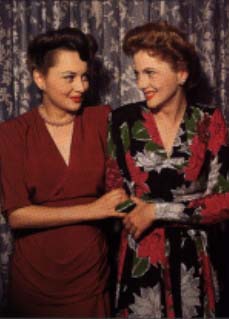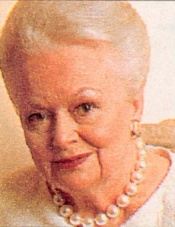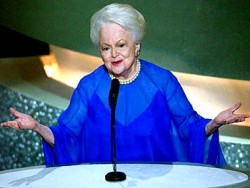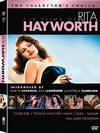





Olivia de Havilland
Biography | Filmography | Awards | Article | Bibliography | Links | Downloads | News | Image Credits | GONE WITH THE WIND | Screen Teams: Errol Flynn & Olivia de Havilland
| Biography: |
|
OLIVIA MARY DE HAVILLAND was born on the first of July 1916 to Walter Augustus de Havilland and his wife, Lillian Augusta Ruse, in Tokyo, Japan where her father was working as an English patent attorney. Her younger sister Joan was born fifteen months later. In 1919, Lillian and Walter separated, and Lillian brought Olivia and Joan to Saratoga, California, where in 1925 she married George M. Fontaine, a department store owner. Growing up in California, Olivia attended Los Gatos Union High School where she lettered in field hockey, and also participated in debate, the dramatic club, and the yearbook staff. In 1933, Olivia made her stage debut in the title role of the Saratoga Community Players production of "Alice in Wonderland," and the following summer after she graduated from high school, she was cast as Puck in their production of William Shakespeare's "A Midsummer Night's Dream.". Having earned a scholarship to nearby Mills College, Olivia originally planned to study English and become a teacher, but a talent scout for director Max Reinhardt caught her performance as Puck and convinced her to join his pageant production of the play (understudying the role of Hermia) later that summer at the Hollywood Bowl. When Gloria Stuart dropped out of the production, Olivia went on as Hermia and was later chosen by Warner Bros. to play the role in their film adaptation of A MIDSUMMER NIGHT'S DREAM (1935), also to be directed by Reinhardt. Olivia then gave up going to college and signed a seven-year contract with the studio.
At only nineteen, many of Olivia's early roles were that of a sweet-tempered beauty opposite the gallant Errol Flynn in various costume adventure movies such as CAPTAIN BLOOD (1935), THE CHARGE OF THE LIGHT BRIGADE (1936), THE ADVENTURES OF ROBIN HOOD (1938) and THEY DIED WITH THEIR BOOTS ON (1941). In total, the pair appeared in nine films together between 1935 and 1943. Most of these films were box-office successes but did little to further de Havilland's career as an actress instead of a clothes horse. De Havilland's first serious role came in 1939 when she was loaned out to David O. Selznick to play the angelic Melanie Wilkes alongside Vivien Leigh, Clark Gable and Leslie Howard in the epic Best Picture of the year, GONE WITH THE WIND. Though she did not take the prize, de Havilland received her first Academy Award nomination as Best Supporting Actress for this role. (She lost to co-star Hattie McDaniel.) Following her return to Warner Bros., de Havilland was disappointed to find that her stock had not risen with the studio, and she was not offered more substantial, non-decorative roles. She appeared with Bette Davis and Flynn in THE PRIVATE LIVES OF ELIZABETH AND ESSEX (1939), but it wasn't until Paramount borrowed her to appear in HOLD BACK THE DAWN (1941) that de Havilland was again challenged to put her talents to use and earned a second Oscar nomination, this time in the Best Actress category. When better roles still did not follow at her home studio, de Havilland began to refuse parts and was frequently put on suspension. After notable performances in THE STRAWBERRY BLONDE (1941), IN THIS OUR LIFE (1942) and PRINCESS O'ROURKE (1943), de Havilland announced that her seven years with Warner Bros. had expired, but the studio claimed it had the right to append her six months of suspension time to the end of her contract. In 1943, de Havilland sued the studio for release from the contract, and after an 18 month court battle during which she was not permitted to make any films, in December 1945 she finally won. The court's decision in her favor marked a major victory for actors' rights in the studio system era. De Havilland spent much of her court battle time "in exile" from Hollywood, entertaining servicemen in hospitals on USO-sponsored tours in the United States, the Aleutians, and the South Pacific. Once her court battle was over, de Havilland returned to Hollywood and began free-lancing. Free to chose more challenging roles, she scored a huge success as an unwed mother in TO EACH HIS OWN (1946) and earned her first Best Actress Oscar for the effort. She received her fourth Academy Award nomination for her performance as a mental patient in THE SNAKE PIT (1948), and took home her second Oscar for her role as a spinster wooed for her money in William Wyler's THE HEIRESS (1949). In 1946, while performing in a summer stock production of "What Every Woman Knows" in Westport, Connecticut, de Havilland renewed an acquaintance with novelist Marcus Aurelius Goodrich (who was 18 years her senior), and the two were married on August 26. In 1949, after completing filming for THE HEIRESS, de Havilland gave birth to a son, Benjamin Briggs, and left the big screen for a time. Among her stage appearances over the next few years were a limited engagement in "Romeo and Juliet" on Broadway in 1951, and a transcontinental tour in the title role of George Bernard Shaw's "Candida" in 1952.
Beginning in 1952 with MY COUSIN RACHEL, de Havilland continued to appear in films throughout the 1950s, although much less frequently than in the 1930s and 1940s. She and Goodrich were divorced in 1953, but two years later she moved to France and married French magazine editor Pierre Galante with whom she had a daughter, Gisele, in 1956. In 1962 de Havilland published a delightful book called Every Frenchman Has One about her difficulties and adventures adjusting to life in France, and that same year she returned to the big screen after a three year absence, as the mother of a mentally retarded girl who wants to get married in LIGHT IN THE PIAZZA. Also in 1962, de Havilland achieved the greatest stage success of her career when she appeared opposite Henry Fonda in the New York production of Garson Kanin's "The Gift of Time," a play about a woman caring for her husband who is terminally ill with cancer. De Havilland's role as Miriam in HUSH... HUSH, SWEET CHARLOTTE (1964) with Bette Davis and Joseph Cotten was one of her more significant film roles of this later period, as was LADY IN A CAGE (1964), a controversial film about a woman trapped in an elevator who is tormented to the verge of insanity. The film received harsh criticism in the United States and was actually banned in England for its excessive violence.
Throughout the 1970s and 1980s, de Havilland continued to appear sporadically in pictures, made-for-TV movies and a few mini-series. She played Henry Fonda's wife, Mrs. Warner, in the "Roots: The Next Generations" mini-series of 1979, the Queen Mother in "The Royal Romance of Charles and Diana" for CBS in 1982, and in 1986 earned an Emmy nomination and a Golden Globe Award for her portrayal of the Dowager Empress in "Anastasia: The Mystery of Anna." She has not played a role for television since 1988 however. After several years of legal separation, de Havilland and her second husband, Pierre Galante, were divorced in 1979, yet after he was diagnosed with cancer, she cared for him until his death in 1998. In 1991, de Havilland's son, Benjamin Goodrich, a statistical analyst, died of complications from Hodgkin's disease at his mother's home in Paris, France. De Havilland herself still resides in Paris where she is working on her autobiography. In 2003, she appeared on the 75th Annual Academy Awards during a segment of the telecast honoring previous Oscar winners. |
|||
|
Return to the Olivia de Havilland main page. |
| Now in Print! |
|---|
| Now on DVD! |
|---|
Buy Videos & DVDs |
|
Buy Movie Posters |
|
Buy Movie Posters |
|
Classic
Movie Merchandise |
|
![]() Printer-friendly version.
Printer-friendly version.
![]() Return
to the top.
Return
to the top.
Last updated:
March 10, 2011.
Reel Classics is a registered trademark of Reel Classics, L.L.C.
© 1997-2011 Reel Classics, L.L.C. All rights reserved. No
copyright is claimed on non-original or licensed material.
Terms of
Use.












